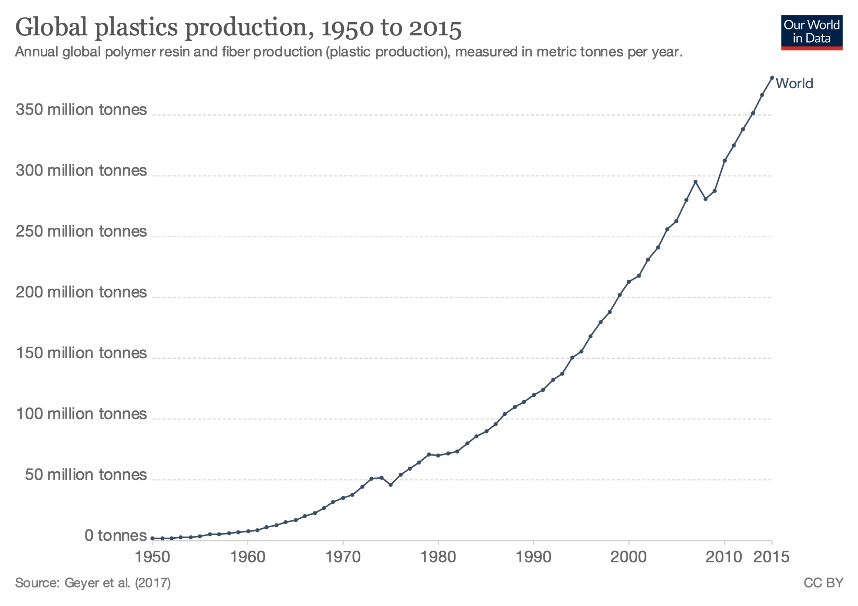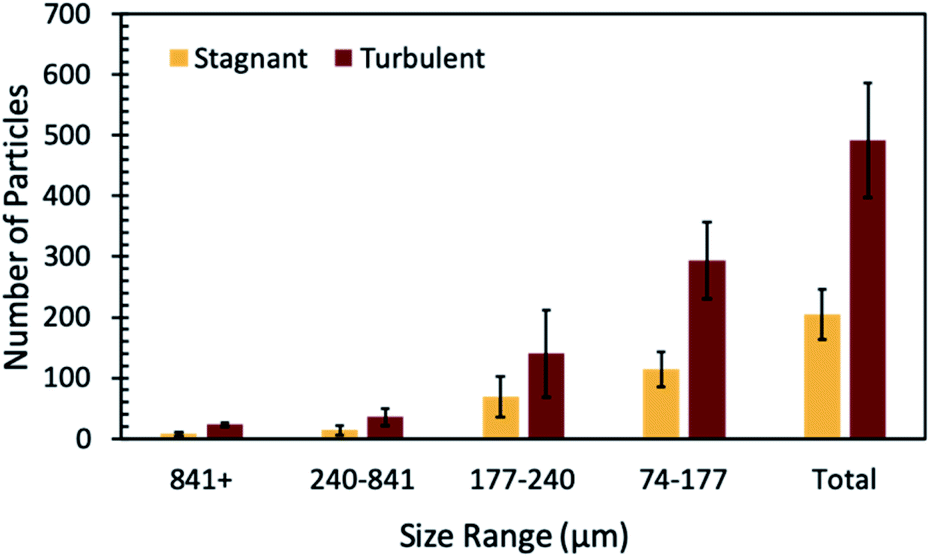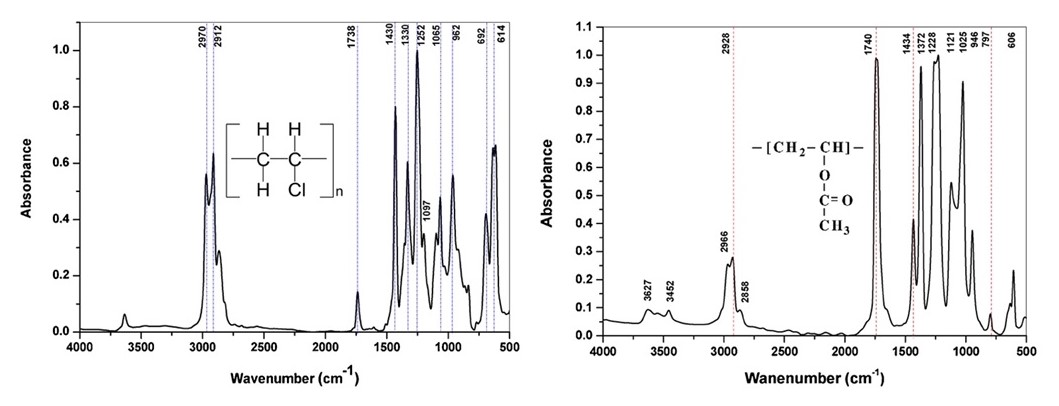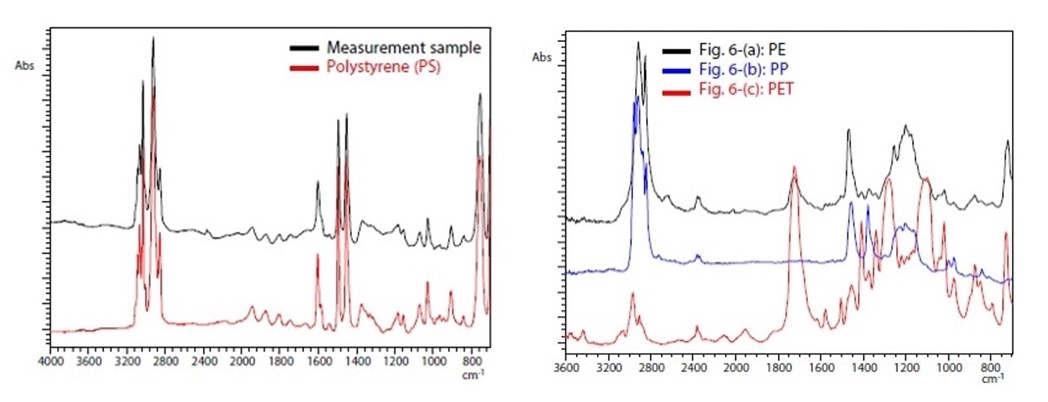Introduction
Over the past decades, humankind has made incredible technological progress, and every day, there are discoveries that have the potential to change society fundamentally. Although the first synthetic plastics appeared in the middle of the 19th century, their widespread use began only about fifty years ago. For instance, for a modern human, plastic products are not something surprising because of the close daily interaction with such materials. Plastic cups, tubes and containers already seem to be an integral part of society’s life, without which it is difficult to imagine the normal functioning of catering systems, medical facilities and the construction industry. Although the demand for plastics grows every year, humanity is not in a hurry to recycle or recover them, which is why a certain proportion of plastics end up in landfills. Thus, the vast majority of people do not take into account the fact that plastic is a serious environmental hazard not only for humankind but for all natural ecosystems and soil in particular. That is why the purpose of this literature review is to summarise scientific information on the extent of the environmental crisis and the nature of microplastics contamination of soil. Much of the work is devoted to researching methods for measuring plastic contamination in soil.
Threats from microplastics
Identification of problem
Identification of threats expressed through plastic soil contamination must be preceded by a semantic analysis of the research topic. It should be said that plastic is a term used in many areas to describe both the physical and chemical properties of a material and a specific type of polymer. In science, polymers are traditionally understood to be macromolecules that have a comparatively long molecular chain consisting of corresponding monomers (Evans and Watkins, 2017). For instance, the plastic polymer polyvinyl chloride shown in Figure 1 has a molecular composition in the form of repetitive links of vinyl chloride.

The complexity of the composite structure of plastics can be intensified by technological modification with plasticisers, substances that increase the thermal and chemical resistance of compounds. According to information provided by Sinha (2017), the plasticiser market is proliferating, and by 2022, the market can be expected to increase to 22% compared to 2015. At the same time, epoxides, terephthalates, esters and phthalates, which are responsible for flexibility, durability and thermal stability of plastic products, remain the primary modifiers of plastics. Taken together, this means that the identification of plastic contaminants can be complicated by the complex composition of the product. All of the above leads to the conclusion that plastics are incredibly large organic molecules with a correspondingly high molecular weight.
Inappropriate treatment of plastic products, their improper disposal and lack of recycling are leading urban and natural systems to a serious environmental crisis. It must be recognised that, coupled with an aesthetic problem, plastic contaminants pose a biological threat to life: this is particularly true in landfill sites where products are not correctly disposed of but are accumulated, pressed and degraded over several years or even decades (Plastic waste, 2019). According to Cressey (2016), the amount of plastic produced by the global community is increasing every year, and the mass-produced by 2015 is estimated to be 300 million tonnes. However, the authorities in Westminster show that by 2018 the number of plastics has reached 380 million tonnes (Plastic waste, 2019). The overall trends in plastic waste production are shown in Figure 2.

Such grandiose statistics on plastics production clearly reflect the probability of poor post-production handling. The majority of plastic products are disposable, and immediately after use, they fall into the bin. Thus, a significant part of plastic that has not yet been assessed gets into the soil in various ways (Bläsing and Amelung, 2018). This phenomenon has a number of adverse effects that affect not only the natural life of the inhabitants of soil environments but also people.
As a follow-up to this issue, it should be noted that the unobvious problem of plastic contaminants is not what they are, but what they can become. It is known that as a result of prolonged ultraviolet and infrared exposure — usually expressed through sunlight — and abrasion from particle impacts or friction against abrasive soil surfaces, large plastic particles are shredded to microscopic dimensions (Zhu et al., 2019). The resulting particles are called microplastics: they were first scientifically described in a study by Carpenter and Smith in 1972 (Corcoran, Biesinger, and Grifi, 2009). Although the term began to be used more widely over time and was best known by 2020, there are still no reference specifications on the size limits of such particles. Traditionally, microplastics refers to extremely small particles of plastic material with a linear size typically less than 5 mm.
It is difficult to imagine that microplastics entering the soil environment can produce any positive results or at least maintain the current dynamics of ecosystems. On the contrary, many studies focused on the problem of microplastics in soils point to serious consequences from such invasive interventions (Zhang and Liu, 2018; Boots, Russell, and Green, 2019; Guo et al., 2020). Threats to the natural environment caused by the presence of microplastics in soils can be differentiated into at least three categories:
- fertility problems,
- suppression of soil organism growth,
- and harm to agriculture.
Threats to soil fertility
The most important task of agronomy and environmental monitoring is to conduct in-depth research into the negative processes that develop in soils as they intensify pollution, which significantly limits crop productivity. Soil fertility is a central criterion of the quality of agricultural land in order to select it as the area to be used. The main determinants of satisfactory soil condition are pH, micronutrient composition, plant ability to access nutrients and water quality (Grant, 2016). For instance, it is known that microplastics deposited in soil layers significantly impede the penetration of liquids and nutrients into plants. Moreover, modified polymers that have toxic inclusions in the soil cause the inevitable diffusion of toxic compounds into the environment (Xu et al., 2020). This fact has a negative impact both on soil acidity and on the survival of organisms that form the microflora of soil resources, and on nitrogen and humus bacteria (Lladó, López-Mondéjar and Baldrian, 2017). Soil with dead or defective microorganisms becomes an unfavourable environment for plant development.
Suppression of organism growth
It is known that soil organisms, in particular earthworms, play a role in the nutrient saturation of land, and therefore any interference with their activities can have a severe negative impact on ecosystems and prevent the growth of the crops that people eat. Worms absorb dead organic matter, improve soil structure, promote drainage and even prevent erosion (Cunha et al., 2016). With this in mind, the suppression of soil worms is particularly serious. According to a study by Boots, Russell, and Green (2019), exposure to plastic, which is commonly used to produce bottles and bags, resulted in earthworms losing 3.1% of their weight in a 30-day period. Reducing weight and underdevelopment can seriously damage biodiversity. Although the exact causes of this phenomenon have not yet been identified, the suppression effect appears to be similar to that seen in hydrobionts (Browne et al., 2008; Li, Tse, and Fok, 2016). In aquatic worms, microplastics cause obstruction and irritation of the digestive tract, making it more difficult for animals to absorb nutrients, and their growth slows down. By the way, any contamination that affects the health of rainworms can have a negative impact on other aspects of the soil ecosystem, such as plant growth.
Plant quality
Although microplastics are actually relatively small, for several decades researchers believed that plastic particles were too large to pass through the physical barriers of undamaged plant tissue. However, microplastic particles have a size range that depends on the chemical composition of the raw material, the degree of degradation and the shelf life, as shown in Figure 3 (Lehtiniemi et al., 2018). This feature allows the smallest polymer particles to penetrate the organism through root pressure from the soil environment.

Much research has not yet been done on the deposition of microplastics in agricultural plants, but it is already clear that this phenomenon is responsible for the transfer of material through food chains. Under such conditions, it does not seem challenging to formulate a cause-and-effect relationship with the potential to cause harm to living beings and nature. For example, humans improperly dispose of plastic waste, which, under the influence of photodestruction, penetrates groundwater and soil as microplastic particles. Such particles can enter the inner cavity of plants, becoming their natural foreign components. Given the small size of microplastic particles, the consumer will not notice that the plant is replete with, for instance, polyvinyl chloride or polystyrene components, which will lead to a consumption of agricultural products (Neill, 2020). There are concerns that all organisms that eat vegetables and fruits rich in microplastics may experience serious health problems.
Ways microplastics can enter the soil
Although the existence of microplastic deposits in the soil is confirmed, the study of pathways of invasion requires more in-depth investigation. In fact, the diversity of plastic particles meets the ambiguity of the opinions of various authors. For example, according to He et al. (2018), the primary source of this type of pollution is the agricultural sector, which is responsible for the adequate use of resources. Mulching, which is a system for protecting the land against drought, physical impact or nutrient deficiencies, is also a serious hazard since even after washing out more plastic, mulch leaves micro-particles in the immediate vicinity of the plant. On the other hand, some authors are convinced that landfills are the dominant factor in the enrichment of soil environments with microplastic particles (Lamizana, 2018). Microplastic is formed from bags, bottles, plastic packaging, car tyres or peeled paint, it is contained in urban dust and is also flushed down the drain after each wash of synthetic fabrics. Moreover, plastic pellets are purposefully added to shampoos, shower gels, detergents and toothpaste for better cleaning effect due to abrasive materials. This means that microplastics have several ways of infiltrating the soil, which only makes it more challenging to contain contaminants.
Methods for testing microplastics in soil
Due to the lack of unique colour or structural properties, microplastic particles are extremely difficult to detect in natural ecological systems. Therefore, in order to overcome the difficulties associated with the laboratory examination of the presence of polymer plastic particles in the objects under analysis, it is common to resort to various identification methods. It is essential to clarify that there are several identification and analysis technologies in the scientific community, each of which was developed for strictly defined tasks. Without focusing in detail on the full range of research techniques, particular attention should be paid to infrared detection methods modified by the use of convolutional neural networks.
Analysing utilising infrared radiation
Although the scientific community periodically offers new ways to identify and analyse microplastic contaminants in natural environments, infrared spectroscopy remains the classical method of identification. Of primary importance is the need to introduce the reader to the essence of this optical method. For instance, vibrational spectroscopy, which is based on measuring the vibrations of molecules or atoms as a function of their exposure to electromagnetic radiation, occupies an important place in the study of the molecular structure of chemical compounds (Beć, Grabska, and Huck, 2020). In particular, this method makes it possible to establish the nature and content of atomic groups, obtain data on the content of functional groups, especially those that cannot be characterised by chemical methods, establish the nature of the chemical bond and study the kinetics of chemical reactions, as shown in Figure 4. Infrared spectroscopy has traditionally been used to identify organic polymers due to the sufficient size of molecules to correspond to the wavelength of the infrared range.

The analysis of microplastics on spectrophotometers should be preceded by a sample preparation procedure for the material. Traditional methods implemented at this stage include extraction of raw materials from soil samples, washing and packaging for further investigation. Microplastic fragments placed on a crystal surface are excited by infrared radiation, the results of which are recorded as a spectrogram. Utilising peaks and characteristic lines, researchers can identify the type of plastic found in a soil sample by comparing different characteristic bands and detecting differences, as shown in Figure 5. In this way, a potentially contaminated area of soil can be examined for chemical composition in order to detect specific polymer components: an example of this spectrum is shown in Figure 3.

Although infrared spectroscopy is actually a working method of analysing biological components, the use of a spectrophotometer presents a number of challenges that can affect the final result. In particular, this applies to the following factors: (i) clarification of the homogeneity of microplastics invasion in terms of depth, (ii) and area, (iii) and accounting for microplastics concentration. To discuss the first two problems, it is necessary to design an agricultural field model. In the event of microplastic contamination of the soil, it is difficult to predict the homogeneity of the particle distribution in volume. Given that mulching may be the primary source of microplastics for soils, it can be assumed that microplastics will concentrate on the surface of the land (He et al., 2018). Although this is generally a fairly logical approach to the study of soil contamination, it must be considered that there are also alternatives: Guo et al. (2020) have shown that the difference between microplastics saturation of deep soil layers and shallow soil layers does not exceed 20%. This means that more data, including distribution patterns, is needed for proper infrared spectroscopy, which provides qualitative results. In this case, it is necessary to change the sample preparation guidelines or, most practical, to carry out multi-component analyses of the different layers.
Above has been shown how Fourier-based infrared spectrophotometers solve the task of analysing soil samples. Indeed, traditional working instruments — such as the AIM-9000 IM and IRTracer-100 — can be used to identify the plastic composition of the soil, but this data is not sufficient to determine the concentration of contaminants (Using infrared spectroscopy for microplastic analysis, 2018). An important issue for both environmental monitoring and the agricultural sector is not only the qualitative analysis of soils but also the determination of the number of contaminants in order to assess future actions. There are several technologies available in the scientific literature to modify spectroscopic studies aimed at recording the concentration of substances, but two of them are of particular interest. These include the use of a mathematical model of the resonance frequency shift and the use of convolution neural networks for computer analysis.
Magnetic resonance spectroscopy can be used to address the concentration of microplastic particles. It should be said that proton magnetic resonance spectroscopy is based on changes in the resonance frequency of the protons that make up the plastics: the so-called chemical shift (Xin and Tkáč, 2017). The information obtained using this method makes it possible to numerically estimate the content of the particles studied in the soil in ppm. In particular, Malyuskin (2020) reported that the model described above successfully handles the analysis of soil samples in real-time and shows concentrations of microplastics up to 100 ppm. In other words, it should be noted that neglecting this technology does not seem expedient, since magnetic resonance spectroscopy not only makes it possible to estimate the number of microplastics in soil but also to reduce the cost of the experiment (Malyuskin, 2020). Although the apparent advantage of this identification method is its ease of use, there are alternatives for quantitative analysis of microplastic soil contamination.
Modification by convolution neural networks
The primary objective of this section is to discuss the phenomenon that has laid down a revolutionary approach to microplastics spectroscopic analysis. Traditionally, machine learning has been defined as a method of data analysis that automates the construction of an analytical model (Hao, 2018). It is a branch of artificial intelligence based on the idea that systems can learn from data, identify patterns and make decisions with minimal human intervention. The core of machine learning is retrospective data analysis: in order for a computer to be able to classify and identify elements on its own, it must be trained to do so.
Over the years, achievements in the field of machine vision with in-depth training have been improved mainly utilising a specific algorithm, namely convolution neural networks. This is an algorithm capable of obtaining an image as an input, assigning a degree of importance to its various aspects or objects and distinguishing recognition categories. It is interesting to note that the ConvNet architecture is similar to the human brain’s neuron binding pattern, and is based on the organisation of its visual zone (Mahapattanakul, 2019). Individual neurons respond to stimuli only in a limited area of the visual field, called the receptive area. These fields overlap to form a collection that covers the entire field of vision.
Infrared spectroscopy, modified by computer vision, is able not only to distinguish substances by their atomic composition but also to calculate their concentrations. As already mentioned, the output of the spectrophotometer is an image: a spectrum of peaks and stripes, individual for each substance. ConvNet eliminates the need for spectroscopists to thoroughly diagnose each spectrum by independently comparing the data obtained with standards stored in libraries (DePaoli, 2019; Ghosh et al., 2019). However, neural networks do not allow for wavelength pre-processing, but instead evaluate the entire range (Yuanyuan and Zhibin, 2018). In the future, this approach has the potential to broaden the researcher’s knowledge of the quantitative ratios of microplastics within soil samples. This becomes particularly important in environmental surveys.
Conclusion
This literary review was useful for a generalised understanding of the problem of micro-plastic soil contamination. The review showed that microplastics hitting the soil in various ways cause severe damage to both nature and the human community. For this reason, an in-depth analysis of the current problem and the subsequent search for solutions is an essential prerequisite for maintaining environmental safety. There is no doubt that modern soil is saturated with microplastics, and this concentration can become fatal. Many authors suggest using the Fourier-transform infrared spectroscopy method to identify the qualitative composition of plastic soil contamination accurately. Indeed, this is an effective method, but it is advisable to find alternatives for quantitative analysis of plastic soil contamination concentrations. Two solutions have been proposed in this work: (i) the use of proton magnetic resonance spectroscopy, (ii) and modification of existing infrared spectroscopy methods by convolutional neural network technologies.
Reference List
Abdelghany, A.M., Meikhail, M.S. and Asker, N. (2019) ‘Synthesis and structural-biological correlation of PVCPVAc polymer blends’, Journal of Materials Research and Technology, 8(5), pp. 3908-3916.
Beć, K.B., Grabska, J. and Huck, C.W. (2020) ‘Near-infrared spectroscopy in bio-applications’, Molecules, 25(12), p. 2948.
Bläsing, M. and Amelung, W. (2018) ‘Plastics in soil: Analytical methods and possible sources’, Science of the Total Environment, 612, pp. 422-435.
Boots, B., Russell, C.W. and Green, D.S. (2019) ‘Effects of microplastics in soil ecosystems: Above and below ground’, Environmental Science & Technology, 53(19), pp. 11496-11506.
Browne, M.A., Dissanayake, A., Galloway, T.S., Lowe, D.M. and Thompson, R.C. (2008) ‘Ingested microscopic plastic translocates to the circulatory system of the mussel, Mytilus edulis (L.)’, Environmental Science & Technology, 42(13), pp. 5026-5031.
Cressey, D. (2016) ‘The plastic ocean’, Nature, 536(7616), pp. 263-265.
Cunha, L., Brown, G.G., Stanton, D.W., Da Silva, E., Hansel, F.A., Jorge, G., McKey, D., Vidal-Torrado, P., Macedo, R.S., Velasquez, E. and James, S.W. (2016) ‘Soil animals and pedogenesis: The role of earthworms in anthropogenic soil’, Soil Science, 181(3/4), pp. 110-125.
DePaoli, D.T., Tossou, P., Parent, M., Sauvageau, D. and Côté, D.C. (2019) ‘Convolutional neural networks for spectroscopic analysis in retinal oximetry’, Scientific Reports, 9(1), pp. 1-13.
Evans, D. and Watkins, S. (2017) Polymers: from DNA to rubber ducks. Web.
Grant, C.A. (2016) Soil fertility and management. International Encyclopedia of Geography: People, the Earth, Environment and Technology: People, the Earth, Environment and Technology, pp. 1-10.7.
Ghosh, K., Stuke, A., Todorović, M., Jørgensen, P.B., Schmidt, M.N., Vehtari, A. and Rinke, P. (2019) ‘Deep learning spectroscopy: neural networks for molecular excitation spectra’, Advanced Science, 6(9), p.1801367.
Guo, J.J., Huang, X.P., Xiang, L., Wang, Y.Z., Li, Y.W., Li, H., Cai, Q.Y., Mo, C.H. and Wong, M.H. (2020) ‘Source, migration and toxicology of microplastics in soil’, Environment International, 137, p.105263-105281.
Hao, K. (2018) What is machine learning? Web.
He, D., Luo, Y., Lu, S., Liu, M., Song, Y. and Lei, L. (2018) ‘Microplastics in soils: Analytical methods, pollution characteristics and ecological risks’, TrAC Trends in Analytical Chemistry, 109, pp.163-172.
Hebner, T.S. and Maurer-Jones, M.A. (2020) ‘Characterizing microplastic size and morphology of photodegraded polymers placed in simulated moving water conditions’, Environmental Science: Processes & Impacts, 22(2), pp. 398-407.
Mahapattanakul, P. (2019) From human vision to computer vision — convolutional neural network (part3/4). Web.
Malyuskin, O (2020) ‘Microplastic detection in soil and water using resonance microwave spectroscopy: A feasibility study’, IEEE Sensors Journal, pp. 1-9.
Lamizana, B. (2018) Plastic planet: How tiny plastic particles are polluting our soil. Web.
Lehtiniemi, M., Hartikainen, S., Näkki, P., Engström-Öst, J., Koistinen, A. and Setälä, O. (2018) ‘Size matters more than shape: Ingestion of primary and secondary microplastics by small predators’, Food Webs, 17, pp. 1-6.
Li, W.C., Tse, H.F. and Fok, L. (2016) ‘Plastic waste in the marine environment: A review of sources, occurrence and effects’, Science of the Total Environment, 566, pp. 333-349.
Lladó, S., López-Mondéjar, R. and Baldrian, P. (2017) ‘Forest soil bacteria: diversity, involvement in ecosystem processes, and response to global change’, Microbiology and Molecular Biology Reviews, 81(2), pp. 1-8.
Neill, P. (2020) Microplastics are contaminating fruit and veg. Web.
Plastic waste – everything you need to know (2019) Web.
Polyvinyl chloride polymer chemical structure, illustration (2019) Web.
Ritchie, H. and Roser, M. (2018) Plastic pollution. Web.
Sinha, S. (2017) Plasticizers market overview. Web.
Using infrared spectroscopy for microplastic analysis (2018) Web.
Xin, L. and Tkáč, I. (2017) ‘A practical guide to in vivo proton magnetic resonance spectroscopy at high magnetic fields’, Analytical Biochemistry, 529, pp. 30-39.
Xu, B., Liu, F., Cryder, Z., Huang, D., Lu, Z., He, Y., Wang, H., Lu, Z., Brookes, P.C., Tang, C. and Gan, J. (2020) ‘Microplastics in the soil environment: Occurrence, risks, interactions and fate – A review’, Critical Reviews in Environmental Science and Technology, 50(21), pp. 2175-2222.
Yuanyuan, C. and Zhibin, W. (2018) ‘Quantitative analysis modeling of infrared spectroscopy based on ensemble convolutional neural networks’, Chemometrics and Intelligent Laboratory Systems, 181, pp. 1-10.
Zhang, G. S., and Liu, Y. F (2018) ‘The distribution of microplastics in soil aggregate fractions in southwestern China’, Science of the Total Environment, 642, pp. 12-20.
Zhu, K., Jia, H., Zhao, S., Xia, T., Guo, X., Wang, T. and Zhu, L. (2019) ‘Formation of environmentally persistent free radicals on microplastics under light irradiation’, Environmental Science & Technology, 53(14), pp. 8177-8186.